Learn why face is not always the place in The Elder Scrolls: Legends
Improve your lane placement and damage decisions with tips from our expert.
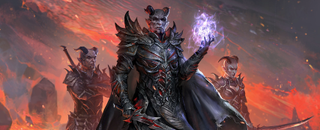

CVH is a veteran CCG player currently focused on The Elder Scrolls: Legends. Already a consistent high-legend player, having hit #1 earlier this season, he streams the game on Twitch and runs Between the Lanes, a site dedicated to strategy content for the game.
Getting into any new CCG feels daunting for two reasons. Obviously there’s the the necessity of building another card collection, but there’s also the added fear of playing against people who know the game’s intricacies and systems inside out. Nonetheless, with Legends recently entering open beta, now is the perfect time to jump in. Despite the similarities between The Elder Scrolls: Legends and other card games like Hearthstone and Magic: the Gathering, it remains unquestionably its own game.
For those of you who, like me, wish to be competitive as quickly as possible, this article is aimed at arming you with all the info needed to have you climbing the ladder successfully from the start. The topics I focus aren’t really what I’d call common mistakes, but rather the things you have to consider in this game that you might not have had to in other CCGs. The differences in Legends, however minor they might appear on first glance, are what add so much to its depth—and as we know, with more depth comes more room for error.
The importance of lane placement
The first thing everyone notices when seeing a game of Legends is that the game board is split in half down the middle into two 'lanes.' Creatures can be summoned on either side, with room for up to four on each of your lanes. Those put in the right (or “Shadow”) lane gain Cover and can’t be attacked for one turn. Unless they specifically state otherwise, creatures can only attack creatures in the same lane, or the opponent directly.
An emphasis on placement is nothing new in card games. Duelyst and Faeria have both attempted to set themselves apart with similar mechanics. While those games have gone for more chess-like game boards, Legends’ approach is more similar to a traditional card game. With only two lanes, your placement options are limited, but it still adds a layer of strategy that doesn’t exist in Hearthstone, especially when you consider the implications of the Shadow lane.
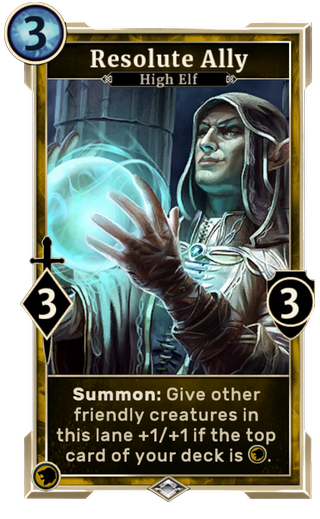
If your opponent is loading one lane with creatures, they may be setting up a buff card.
Newer players might assume that placement has little relevance, especially early on when the board is empty. The faster you get out of this mindset, the better—trust me. Having the initiative on board, and making favorable trades, is as important in Legends as it is in any other card game, and you must navigate the two lanes correctly in order to do these things successfully.
For example, if I’m the first player to put a creature on board, I will usually be summoning it in the left “Field” lane instead of the Shadow lane. The reason is that if my opponent plays a creature in the left lane to contest mine, I am the player who is able to decide whether I want to trade or go face. If they can’t deal with my creature or simply don’t want to, they can put one in the Shadow lane. If I then put a creature in the Shadow lane to contest theirs, mine will gain Cover, be invulnerable to attacks, and I will still be the player who gets to decide whether to trade or go face in that lane.
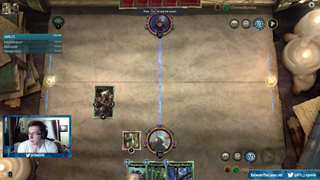
Of course, this is just a basic guideline, and due to the effects of other creatures and Actions, things don’t always work out exactly as planned. Against decks that might be running creatures with Charge, I will occasionally develop the first threat in the Shadow lane if I really need to protect it from getting attacked immediately.
The biggest gaming news, reviews and hardware deals
Keep up to date with the most important stories and the best deals, as picked by the PC Gamer team.
The lanes also interact with many other cards, which means that knowing the card pool and what to play around against certain decks is paramount. Dawn’s Wrath clears every creature in a lane, Resolute Ally can give +1/+1 to all your other creatures in a lane, and the list goes on. You will have to keep cards like these in the back of your mind every single time you play something to the board, depending on what deck you are running, in order to play around what your opponent is likely to do.
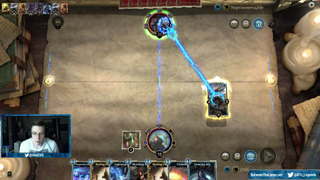
Mind your damage
In Hearthstone, or even MTG, when your opponent doesn’t have any relevant blocks, you are more or less free to deal whatever face damage you can. After all, the goal is to reduce their health to zero. Since Legends is another game in which players have health totals, it seems like it would work the exact same way, and it does to an extent.
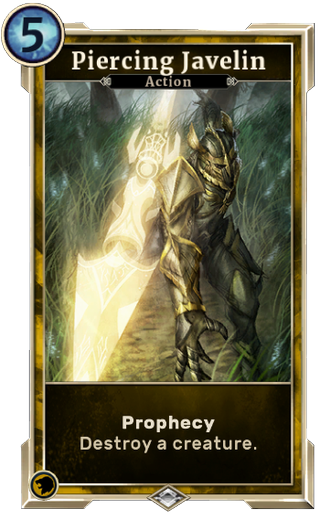
Probably the most powerful Prophecy card in the game. Be aware of what might happen before popping a rune.
The runes around your portrait break at increments of every five damage you take. When that happens, you draw a card from your deck, and if it has the “Prophecy” keyword, you may play it for free, meaning you can interrupt your opponent’s turn in the middle of their attacks. While there are only five of these runes, they represent the main mechanic the game uses to curtail wanton face damage. In other CCGs, once you get ahead, it’s easy to snowball. In Legends, the card advantage you give your opponent from breaking runes ensures they have a chance to come back, to say nothing of the swing turns Prophecy cards can provide.
Every time you have the opportunity to deal face damage, you have to calculate the risks. Ordering attacks correctly to deal the maximum possible guaranteed damage is very important to aggressive decks in particular; making a smaller attack to get the opponent to a life total just above a rune break and then hitting with something huge can mitigate the possibility of a Prophecy card like Piercing Javelin dealing with your large threat before it can attack.
In other cases, when resources are low on both sides, it is frequently correct to skip attacks altogether that would otherwise be free damage, in order to prevent your opponent drawing the extra cards that might turn the tide. One sense check you can use when deciding whether to break a rune, is to imagine the card you're attacking with has text that reads: "deal X damage, your opponent draws a card". Still want to go face? If you're in a damage race situation, the answer may be yes, but at least be aware of the risk.

Depth comes from small decisions
The importance of placement and the risk/reward nature of damage in this game ensure that there are a huge number of potential outcomes on any given turn, even when the number of playable cards in your hand is small. Legends really is a game of options, and efficiently going through all the most relevant outcomes in your head should be routine on every turn. Ordering, placement, and attacks should be considered carefully just as much as the big-picture strategy in each game.
It may seem like quite the task, but through practice, it gets easier and the wins come more naturally. I don’t believe Legends is a game it is possible to play truly successfully without giving it your full attention, but luckily for us, the game is so much fun that this isn’t an issue. Hopefully this has given you some insight into two of the most important pieces of thinking you’ll need to develop coming into Legends from other card games. Best of luck on the ladder, and I hope to queue against you at legend rank soon!
Most Popular

